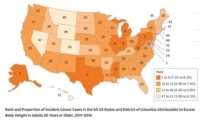 Being overweight can raise a postmenopausal woman’s risk of breast cancer, according to a new study, which finds a link between a higher risk for the disease and a high body mass index (BMI), a measure of body fat based on height and weight.
Being overweight can raise a postmenopausal woman’s risk of breast cancer, according to a new study, which finds a link between a higher risk for the disease and a high body mass index (BMI), a measure of body fat based on height and weight.
The study, which analyzed data on nearly 30,000 (predominantly white) women involved in the Cancer Prevention Study II, appears in the April 2014 issue of Cancer Causes and Control.
Apple-shaped v. pear-shaped
American Cancer Society researchers failed to confirm previous findings that body shape itself is an independent risk factor for breast cancer. A significant body of research has linked abdominal obesity to a number of conditions, including heart disease, type II diabetes, and breast and other cancers. Those studies have led to the theory that having an “apple shaped” body, with weight concentrated in the chest and torso, is riskier than having a “pear-shaped” body, with fat concentrated in the hips, thighs and buttocks.
“The message is that if you have a high BMI, regardless if you are pear or apple shaped, you are at higher risk of breast cancer,” said Dr. Gaudet. “Most prior studies on this issue looked at BMI or at waist circumference, but had not looked at them together. This study brings some clarity to the association between obesity and risk of breast cancer.”
Data can sharpen focus
Dr. Gaudet says the data could help women focus on what’s important in what has been a confusing array of potential risk factors for breast cancer. “We know being overweight, particularly when the weight gain happened during adulthood, is one of the important modifiable risk factors for breast cancer in post-menopausal women. This new data indicates it’s not what shape you are, it’s what kind of shape you are in that probably ought to be their focus.”
Article: Waist circumference, body mass index, and postmenopausal breast cancer incidence in the Cancer Prevention Study-II Nutrition Cohort, M. Gaudet, B Carter, A Patel, L Teras, E Jacobs, S Gapstur, Cancer Causes & Control, April 2014 doi 10.1007/s10552-014-0376-4









